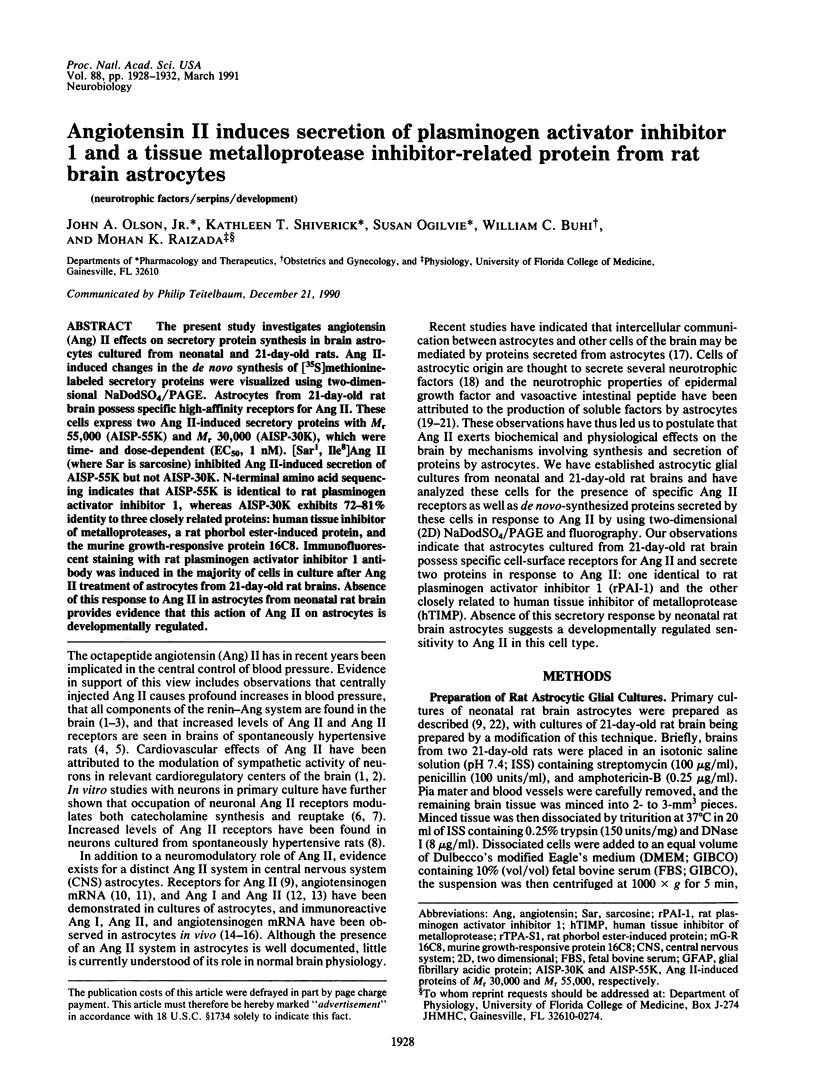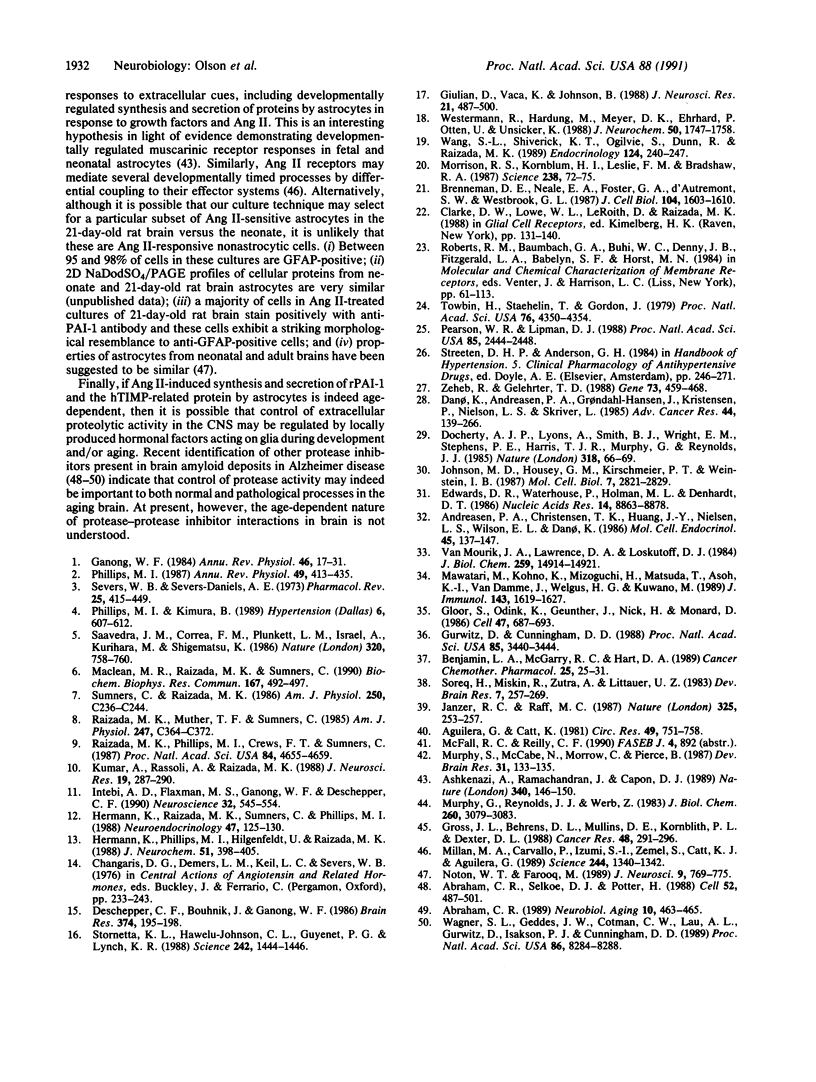Abstract
The present study investigates angiotensin (Ang) II effects on secretory protein synthesis in brain astrocytes cultured from neonatal and 21-day-old rats. Ang II-induced changes in the de novo synthesis of [35S]methionine-labeled secretory proteins were visualized using two-dimensional NaDodSO4/PAGE. Astrocytes from 21-day-old rat brain possess specific high-affinity receptors for Ang II. These cells express two Ang II-induced secretory proteins with Mr 55,000 (AISP-55K) and Mr 30,000 (AISP-30K), which were time- and dose-dependent (EC50, 1 nM). [Sar1, Ile8]Ang II (where Sar is sarcosine) inhibited Ang II-induced secretion of AISP-55K but not AISP-30K. N-terminal amino acid sequencing indicates that AISP-55K is identical to rat plasminogen activator inhibitor 1, whereas AISP-30K exhibits 72-81% identity to three closely related proteins: human tissue inhibitor of metalloproteases, a rat phorbol ester-induced protein, and the murine growth-responsive protein 16C8. Immunofluorescent staining with rat plasminogen activator inhibitor 1 antibody was induced in the majority of cells in culture after Ang II treatment of astrocytes from 21-day-old rat brains. Absence of this response to Ang II in astrocytes from neonatal rat brain provides evidence that this action of Ang II on astrocytes is developmentally regulated.
Full text
PDF




Images in this article
Selected References
These references are in PubMed. This may not be the complete list of references from this article.
- Abraham C. R. Potential roles of protease inhibitors in Alzheimer's disease. Neurobiol Aging. 1989 Sep-Oct;10(5):463–478. doi: 10.1016/0197-4580(89)90097-3. [DOI] [PubMed] [Google Scholar]
- Abraham C. R., Selkoe D. J., Potter H. Immunochemical identification of the serine protease inhibitor alpha 1-antichymotrypsin in the brain amyloid deposits of Alzheimer's disease. Cell. 1988 Feb 26;52(4):487–501. doi: 10.1016/0092-8674(88)90462-x. [DOI] [PubMed] [Google Scholar]
- Aguilera G., Catt K. Regulation of vascular angiotensin II receptors in the rat during altered sodium intake. Circ Res. 1981 Sep;49(3):751–758. doi: 10.1161/01.res.49.3.751. [DOI] [PubMed] [Google Scholar]
- Andreasen P. A., Christensen T. H., Huang J. Y., Nielsen L. S., Wilson E. L., Danø K. Hormonal regulation of extracellular plasminogen activators and Mr approximately 54,000 plasminogen activator inhibitor in human neoplastic cell lines, studied with monoclonal antibodies. Mol Cell Endocrinol. 1986 May;45(2-3):137–147. doi: 10.1016/0303-7207(86)90141-3. [DOI] [PubMed] [Google Scholar]
- Ashkenazi A., Ramachandran J., Capon D. J. Acetylcholine analogue stimulates DNA synthesis in brain-derived cells via specific muscarinic receptor subtypes. Nature. 1989 Jul 13;340(6229):146–150. doi: 10.1038/340146a0. [DOI] [PubMed] [Google Scholar]
- Benjamin L. A., McGarry R. C., Hart D. A. Effect of retinoic acid on human neuroblastoma: correlation between morphological differentiation and changes in plasminogen activator and inhibitor activity. Cancer Chemother Pharmacol. 1989;25(1):25–31. doi: 10.1007/BF00694334. [DOI] [PubMed] [Google Scholar]
- Brenneman D. E., Neale E. A., Foster G. A., d'Autremont S. W., Westbrook G. L. Nonneuronal cells mediate neurotrophic action of vasoactive intestinal peptide. J Cell Biol. 1987 Jun;104(6):1603–1610. doi: 10.1083/jcb.104.6.1603. [DOI] [PMC free article] [PubMed] [Google Scholar]
- Danø K., Andreasen P. A., Grøndahl-Hansen J., Kristensen P., Nielsen L. S., Skriver L. Plasminogen activators, tissue degradation, and cancer. Adv Cancer Res. 1985;44:139–266. doi: 10.1016/s0065-230x(08)60028-7. [DOI] [PubMed] [Google Scholar]
- Deschepper C. F., Bouhnik J., Ganong W. F. Colocalization of angiotensinogen and glial fibrillary acidic protein in astrocytes in rat brain. Brain Res. 1986 May 21;374(1):195–198. doi: 10.1016/0006-8993(86)90411-7. [DOI] [PubMed] [Google Scholar]
- Docherty A. J., Lyons A., Smith B. J., Wright E. M., Stephens P. E., Harris T. J., Murphy G., Reynolds J. J. Sequence of human tissue inhibitor of metalloproteinases and its identity to erythroid-potentiating activity. Nature. 1985 Nov 7;318(6041):66–69. doi: 10.1038/318066a0. [DOI] [PubMed] [Google Scholar]
- Edwards D. R., Waterhouse P., Holman M. L., Denhardt D. T. A growth-responsive gene (16C8) in normal mouse fibroblasts homologous to a human collagenase inhibitor with erythroid-potentiating activity: evidence for inducible and constitutive transcripts. Nucleic Acids Res. 1986 Nov 25;14(22):8863–8878. doi: 10.1093/nar/14.22.8863. [DOI] [PMC free article] [PubMed] [Google Scholar]
- Ganong W. F. The brain renin-angiotensin system. Annu Rev Physiol. 1984;46:17–31. doi: 10.1146/annurev.ph.46.030184.000313. [DOI] [PubMed] [Google Scholar]
- Giulian D., Vaca K., Johnson B. Secreted peptides as regulators of neuron-glia and glia-glia interactions in the developing nervous system. J Neurosci Res. 1988 Oct-Dec;21(2-4):487–500. doi: 10.1002/jnr.490210240. [DOI] [PubMed] [Google Scholar]
- Gloor S., Odink K., Guenther J., Nick H., Monard D. A glia-derived neurite promoting factor with protease inhibitory activity belongs to the protease nexins. Cell. 1986 Dec 5;47(5):687–693. doi: 10.1016/0092-8674(86)90511-8. [DOI] [PubMed] [Google Scholar]
- Gross J. L., Behrens D. L., Mullins D. E., Kornblith P. L., Dexter D. L. Plasminogen activator and inhibitor activity in human glioma cells and modulation by sodium butyrate. Cancer Res. 1988 Jan 15;48(2):291–296. [PubMed] [Google Scholar]
- Gurwitz D., Cunningham D. D. Thrombin modulates and reverses neuroblastoma neurite outgrowth. Proc Natl Acad Sci U S A. 1988 May;85(10):3440–3444. doi: 10.1073/pnas.85.10.3440. [DOI] [PMC free article] [PubMed] [Google Scholar]
- Hermann K., Phillips M. I., Hilgenfeldt U., Raizada M. K. Biosynthesis of angiotensinogen and angiotensins by brain cells in primary culture. J Neurochem. 1988 Aug;51(2):398–405. doi: 10.1111/j.1471-4159.1988.tb01052.x. [DOI] [PubMed] [Google Scholar]
- Hermann K., Raizada M. K., Sumners C., Phillips M. I. Immunocytochemical and biochemical characterization of angiotensin I and II in cultured neuronal and glial cells from rat brain. Neuroendocrinology. 1988 Feb;47(2):125–132. doi: 10.1159/000124902. [DOI] [PubMed] [Google Scholar]
- Intebi A. D., Flaxman M. S., Ganong W. F., Deschepper C. F. Angiotensinogen production by rat astroglial cells in vitro and in vivo. Neuroscience. 1990;34(3):545–554. doi: 10.1016/0306-4522(90)90163-x. [DOI] [PubMed] [Google Scholar]
- Janzer R. C., Raff M. C. Astrocytes induce blood-brain barrier properties in endothelial cells. Nature. 1987 Jan 15;325(6101):253–257. doi: 10.1038/325253a0. [DOI] [PubMed] [Google Scholar]
- Johnson M. D., Housey G. M., Kirschmeier P. T., Weinstein I. B. Molecular cloning of gene sequences regulated by tumor promoters and mitogens through protein kinase C. Mol Cell Biol. 1987 Aug;7(8):2821–2829. doi: 10.1128/mcb.7.8.2821. [DOI] [PMC free article] [PubMed] [Google Scholar]
- Kumar A., Rassoli A., Raizada M. K. Angiotensinogen gene expression in neuronal and glial cells in primary cultures of rat brain. J Neurosci Res. 1988 Mar;19(3):287–290. doi: 10.1002/jnr.490190302. [DOI] [PubMed] [Google Scholar]
- MacLean M. R., Raizada M. K., Sumners C. The influence of angiotensin II on catecholamine synthesis in neuronal cultures from rat brain. Biochem Biophys Res Commun. 1990 Mar 16;167(2):492–497. doi: 10.1016/0006-291x(90)92050-a. [DOI] [PubMed] [Google Scholar]
- Mawatari M., Kohno K., Mizoguchi H., Matsuda T., Asoh K., Van Damme J., Welgus H. G., Kuwano M. Effects of tumor necrosis factor and epidermal growth factor on cell morphology, cell surface receptors, and the production of tissue inhibitor of metalloproteinases and IL-6 in human microvascular endothelial cells. J Immunol. 1989 Sep 1;143(5):1619–1627. [PubMed] [Google Scholar]
- Millan M. A., Carvallo P., Izumi S., Zemel S., Catt K. J., Aguilera G. Novel sites of expression of functional angiotensin II receptors in the late gestation fetus. Science. 1989 Jun 16;244(4910):1340–1342. doi: 10.1126/science.2734613. [DOI] [PubMed] [Google Scholar]
- Morrison R. S., Kornblum H. I., Leslie F. M., Bradshaw R. A. Trophic stimulation of cultured neurons from neonatal rat brain by epidermal growth factor. Science. 1987 Oct 2;238(4823):72–75. doi: 10.1126/science.3498986. [DOI] [PubMed] [Google Scholar]
- Murphy G., Reynolds J. J., Werb Z. Biosynthesis of tissue inhibitor of metalloproteinases by human fibroblasts in culture. Stimulation by 12-O-tetradecanoylphorbol 13-acetate and interleukin 1 in parallel with collagenase. J Biol Chem. 1985 Mar 10;260(5):3079–3083. [PubMed] [Google Scholar]
- Murphy S., McCabe N., Morrow C., Pearce B. Phorbol ester stimulates proliferation of astrocytes in primary culture. Brain Res. 1987 Jan;428(1):133–135. doi: 10.1016/0165-3806(87)90091-5. [DOI] [PubMed] [Google Scholar]
- Norton W. T., Farooq M. Astrocytes cultured from mature brain derive from glial precursor cells. J Neurosci. 1989 Mar;9(3):769–775. doi: 10.1523/JNEUROSCI.09-03-00769.1989. [DOI] [PMC free article] [PubMed] [Google Scholar]
- Pearson W. R., Lipman D. J. Improved tools for biological sequence comparison. Proc Natl Acad Sci U S A. 1988 Apr;85(8):2444–2448. doi: 10.1073/pnas.85.8.2444. [DOI] [PMC free article] [PubMed] [Google Scholar]
- Phillips M. I. Functions of angiotensin in the central nervous system. Annu Rev Physiol. 1987;49:413–435. doi: 10.1146/annurev.ph.49.030187.002213. [DOI] [PubMed] [Google Scholar]
- Phillips M. I., Kimura B. Brain angiotensin in the developing spontaneously hypertensive rat. J Hypertens. 1988 Aug;6(8):607–612. doi: 10.1097/00004872-198808000-00002. [DOI] [PubMed] [Google Scholar]
- Raizada M. K., Muther T. F., Sumners C. Increased angiotensin II receptors in neuronal cultures from hypertensive rat brain. Am J Physiol. 1984 Nov;247(5 Pt 1):C364–C372. doi: 10.1152/ajpcell.1984.247.5.C364. [DOI] [PubMed] [Google Scholar]
- Raizada M. K., Phillips M. I., Crews F. T., Sumners C. Distinct angiotensin II receptor in primary cultures of glial cells from rat brain. Proc Natl Acad Sci U S A. 1987 Jul;84(13):4655–4659. doi: 10.1073/pnas.84.13.4655. [DOI] [PMC free article] [PubMed] [Google Scholar]
- Saavedra J. M., Correa F. M., Plunkett L. M., Israel A., Kurihara M., Shigematsu K. Binding of angiotensin and atrial natriuretic peptide in brain of hypertensive rats. Nature. 1986 Apr 24;320(6064):758–760. doi: 10.1038/320758a0. [DOI] [PubMed] [Google Scholar]
- Severs W. B., Daniels-Severs A. E. Effects of angiotensin on the central nervous system. Pharmacol Rev. 1973 Sep;25(3):415–449. [PubMed] [Google Scholar]
- Soreq H., Miskin R., Zutra A., Littauer U. Z. Modulation in the levels and localization of plasminogen activator in differentiating neuroblastoma cells. Brain Res. 1983 Apr;283(2-3):257–269. doi: 10.1016/0165-3806(83)90182-7. [DOI] [PubMed] [Google Scholar]
- Stornetta R. L., Hawelu-Johnson C. L., Guyenet P. G., Lynch K. R. Astrocytes synthesize angiotensinogen in brain. Science. 1988 Dec 9;242(4884):1444–1446. doi: 10.1126/science.3201232. [DOI] [PubMed] [Google Scholar]
- Sumners C., Raizada M. K. Angiotensin II stimulates norepinephrine uptake in hypothalamus-brain stem neuronal cultures. Am J Physiol. 1986 Feb;250(2 Pt 1):C236–C244. doi: 10.1152/ajpcell.1986.250.2.C236. [DOI] [PubMed] [Google Scholar]
- Towbin H., Staehelin T., Gordon J. Electrophoretic transfer of proteins from polyacrylamide gels to nitrocellulose sheets: procedure and some applications. Proc Natl Acad Sci U S A. 1979 Sep;76(9):4350–4354. doi: 10.1073/pnas.76.9.4350. [DOI] [PMC free article] [PubMed] [Google Scholar]
- Wagner S. L., Geddes J. W., Cotman C. W., Lau A. L., Gurwitz D., Isackson P. J., Cunningham D. D. Protease nexin-1, an antithrombin with neurite outgrowth activity, is reduced in Alzheimer disease. Proc Natl Acad Sci U S A. 1989 Nov;86(21):8284–8288. doi: 10.1073/pnas.86.21.8284. [DOI] [PMC free article] [PubMed] [Google Scholar]
- Wang S. L., Shiverick K. T., Ogilvie S., Dunn W. A., Raizada M. K. Characterization of epidermal growth factor receptors in astrocytic glial and neuronal cells in primary culture. Endocrinology. 1989 Jan;124(1):240–247. doi: 10.1210/endo-124-1-240. [DOI] [PubMed] [Google Scholar]
- Westermann R., Hardung M., Meyer D. K., Ehrhard P., Otten U., Unsicker K. Neuronotrophic factors released by C6 glioma cells. J Neurochem. 1988 Jun;50(6):1747–1758. doi: 10.1111/j.1471-4159.1988.tb02474.x. [DOI] [PubMed] [Google Scholar]
- Zeheb R., Gelehrter T. D. Cloning and sequencing of cDNA for the rat plasminogen activator inhibitor-1. Gene. 1988 Dec 20;73(2):459–468. doi: 10.1016/0378-1119(88)90510-0. [DOI] [PubMed] [Google Scholar]
- van Mourik J. A., Lawrence D. A., Loskutoff D. J. Purification of an inhibitor of plasminogen activator (antiactivator) synthesized by endothelial cells. J Biol Chem. 1984 Dec 10;259(23):14914–14921. [PubMed] [Google Scholar]








